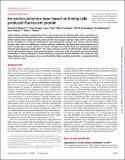An exciton-polariton laser based on biologically produced fluorescent protein
Date
19/08/2016Author
Grant ID
640012
PCIG12-GA-2012-334407
EP/M025330/1
659213
BB/J000337/1
Keywords
Metadata
Show full item recordAbstract
Under adequate conditions, cavity-polaritons form a macroscopic coherent quantum state, known as polariton condensate (PC). Compared to Wannier-Mott polaritons in inorganic semiconductors, the localized Frenkel polaritons in organic emitter materials show weaker interaction with each other but stronger coupling to light, which recently enabled the first realization of a PC at room temperature. However, this required ultrafast optical pumping which limits the applications of organic PCs. Here, we demonstrate room-temperature PCs of cavity-polaritons in simple laminated microcavities filled with the biologically produced enhanced green fluorescent protein (eGFP). The unique molecular structure of eGFP prevents exciton annihilation even at high excitation densities, thus facilitating PCs under conventional nanosecond pumping. Condensation is clearly evidenced by a distinct threshold, an interaction-induced blueshift of the condensate, long-range coherence and the presence of a second threshold at higher excitation density which is associated with the onset of photon lasing.
Citation
Dietrich , C P , Steude , A , Tropf , L C , Schubert , M , Kronenberg , N M , Ostermann , K , Hoefling , S & Gather , M C 2016 , ' An exciton-polariton laser based on biologically produced fluorescent protein ' , Science Advances , vol. 2 , no. 8 , e1600666 , pp. 1-7 . https://doi.org/10.1126/sciadv.1600666
Publication
Science Advances
Status
Peer reviewed
ISSN
2375-2548Type
Journal article
Description
We thank A. Clemens (TU Dresden, Germany) for technical support with protein preparation and C. Murawski (U St Andrews, UK) for support with TDAF deposition. We acknowledge support from the ERC Starting Grant ABLASE (640012), the Scottish Funding Council (via SUPA), the European Union Marie Curie Career Integration Grant (PCIG12-GA-2012-334407), studentship funding through the EPSRC CM-DTC (EP/L015110/1) and the EPSRC Hybrid Polaritonics program grant (EP/M025330/1). S.H. gratefully acknowledges support by the Royal Society and the Wolfson Foundation and M.S. gratefully acknowledges support from a MSCA IF (659213).Collections
Items in the St Andrews Research Repository are protected by copyright, with all rights reserved, unless otherwise indicated.

